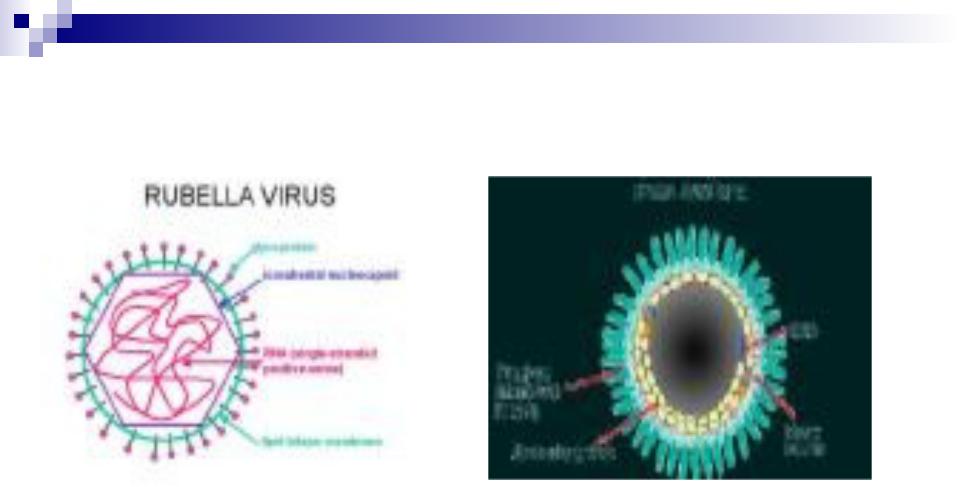
- •RUBELLA
- •Rubella, commonly known as German measles, is a disease
- •tHiS dIsEaSe iS cAuSeD bY….
- •MORPHOLOGY
- •REPLICATION
- •EPIDEMIOLOGY
- •PATHOGENESIS & CLINICAL SYNDROMES
- •SIGNS & SYMPTOMS
- •IMMUNITY
- •CONGENITAL RUBELLA SYNDROME (CRS)
- •CRS can result in serious birth defects such as:
- •LABORATORY DIAGNOSIS
- •PREVENTION
- •TREATMENT & PROPHYLAXIS

 RUBELLA
RUBELLA

Rubella, commonly known as German measles, is a disease
caused by Rubella virus. The name is derived from the Latin language, meaning little red. Rubella is also known as German
measles because the disease was first described by German physicians in the mid-eighteenth century. This disease is often mild and attacks often pass unnoticed. The disease can last one to five days. Children recover more quickly than adults. Infection of the mother by Rubella virus during pregnancy can be serious; if the mother is infected within the first 20 weeks of pregnancy, the child may be born with congenital rubella syndrome (CRS), which entails a range of serious incurable illnesses. Spontaneous abortion occurs in up to 20% of cases. Rubella is a common childhood infection usually with minimal systemic upset although transient arthropathy may occur in adults. Serious complications are very rare. If it were not for the effects of transplacental infection on the developing foetus, rubella is a relatively trivial infection. In most people the virus is rapidly eliminated. However, it may persist for some months post partum in infants surviving the CRS. These children were an important source of infection to other infants and, more importantly, pregnant female contacts.

tHiS dIsEaSe iS cAuSeD bY….
RUBELLA VIRUS
FAMILY: TOGAVIRIDAE GENUS: RUBIVIRUS

MORPHOLOGY
Rubella virus is a spherical, 40 to 80 nm, positive-sense, single- stranded RNA virus with spike-like, haemagglutinin-containing surface projections. An electron-dense 30 to 35 nm core is surrounded by a lipoprotein envelope.
The virus particle, or virion, is enveloped and approximately 60nm in diameter. The virion consists of a single polyadenylated molecule of RNA enclosed in a nucleocapsid.
The surounding envelope is derived from the host cell membrane and viral glycoproteins that form projections approximately 6nm long.
The viral RNA has two open reading frames (ORFs) and untranslated regions (UTRs) at the 5' and 3' ends of the genome.
The virus contains three glycosylated, membrane- associated proteins, El, E2a and E2b, and one unglycosylated nucleocapsid protein, C .


REPLICATION
Rubella virus replicates in the cytoplasm of host cells.
The viral genomic RNA serves as a template for the synthesis of negative sense RNAs which are used to produce cytoplasmic messenger RNA (mRNA).
The mRNAs direct the production of viral proteins and are also packaged as genomic RNA in virions.
The steps are similar to other togoviruses but with the expection that nucleocapsids do not accumulate in the cytoplasm,
Continuous carrier cultures are not uncommon and frequently show many chromosomal breaks and abnormalities,

EPIDEMIOLOGY
Rubella is a disease that occurs worldwide. The virus tends to peak during the spring in countries with temperate climates. Before the vaccine to rubella was introduced in 1969, widespread outbreaks usually occurred every 6-9 years in the United States and 3-5 years in Europe, mostly affecting children in the 5-9 year old age group. Since the introduction of vaccine, occurrences have become rare in those countries with high uptake rates. However, in the UK there remains a large population of men susceptible to rubella who have not been vaccinated. Outbreaks of rubella occurred amongst many young men in the UK in 1993 and in 1996 the infection was transmitted to pregnant women, many of whom were immigrants and were susceptible. Outbreaks still arise, usually in developing countries where the vaccine is not as accessible.
During the epidemic in the US between 1962-1965, Rubella virus infections during pregnancy were estimated to have caused 30,000 still births and 20,000 children to be born impaired or disabled as a result of CRS. Universal immunisation producing a high level of herd immunity is important in the control of epidemics of rubella.


PATHOGENESIS & CLINICAL SYNDROMES
Rubella is highly contagious disease spread by nasal secretions. Because infection often is inapparent, viral dissemination maybe widespread before it is recognized.
Rubella virus infects the upper respiratory tract & then spread to local lymph nodes, which coincides with a period of lymphadenopathy. This is followed by establishment of viremia, which spreads the virus throughout the body. Infection of other tissues and the characteristic mild rash result. The prodromal period lasts approximately 2 weeks. The person can shed virus in respiratory droplet during the prodromall period and for as long as 2 weeks after the onset of the rash.

SIGNS & SYMPTOMS
After an incubation period of 14-21 days, the primary symptom of rubella virus infection is the appearance of a rash (exanthem) on the face which spreads to the trunk and limbs and usually fades after three days. Other symptoms include low grade fever, swollen glands (post cervical lymphadenopathy), joint pains, headache, conjunctivitis. The swollen glands or lymph nodes can persist for up to a week and the fever rarely rises above 38°C (100.4°F). The rash disappears after a few days with no staining or peeling of the skin. Forchheimer's sign occurs in 20% of cases, and is characterized by small, red papules on the area of the soft palates.
Rubella can affect anyone of any age and is generally a mild disease, rare in infants or those over the age of 40. The older the person is the more severe the symptoms are likely to be. Up to one-third of older girls or women experience joint pain or arthritic type symptoms with rubella. The virus is contracted through the respiratory tract and has an incubation period of 2 to 3 weeks. During this incubation period, the carrier is contagious but may show no symptoms.
